Ayodhya, a city that resonates with the echoes of ancient legends and spiritual fervor, stands as a testament to India’s rich cultural tapestry. Nestled on the banks of the sacred Sarayu River in the northern state of Uttar Pradesh, Ayodhya is a pilgrimage site revered by millions. In this blog, we embark on a journey through the hallowed lanes of Ayodhya, exploring the spiritual, historical, and cultural landmarks that make it a destination like no other.
- Ram Janmabhoomi: The Birthplace of Lord Rama
The heart of Ayodhya beats in the sacred precincts of Ram Janmabhoomi, believed to be the birthplace of Lord Rama. A site of immense religious significance, it has been at the center of Hindu mythology for centuries. Devotees flock to witness the grandeur of the Ram Janmabhoomi Temple, a symbol of faith and devotion. The temple, with its architectural brilliance, stands as a tribute to the revered hero of the epic Ramayana.
- Hanuman Garhi: The Abode of Lord Hanuman
Perched atop a hillock, Hanuman Garhi is a fortress-like temple dedicated to Lord Hanuman, the devoted companion of Lord Rama. The temple’s architecture and the panoramic view it offers of Ayodhya make it a must-visit for both pilgrims and tourists. The spiritual ambiance and the sense of tranquility at Hanuman Garhi leave an indelible mark on visitors.
- Kanak Bhavan: A Testament to Devotion
Another jewel in Ayodhya’s crown, Kanak Bhavan is a palace that resonates with tales of devotion. Legend has it that the palace was gifted to Sita by her mother, and it remains a symbol of the love between Rama and Sita. The intricate carvings and paintings within the palace depict scenes from the Ramayana, offering a visual narrative of the epic.
- Sita ki Rasoi: Where Tradition Meets Culinary Heritage
Translated as “Sita’s Kitchen,” this quaint culinary spot is believed to be the kitchen of Sita, where she prepared meals for Lord Rama. Today, Sita ki Rasoi is a unique attraction that reflects Ayodhya’s commitment to preserving its cultural heritage. Visitors can explore the kitchen and witness artifacts that transport them back to the era of the Ramayana.
- Treta Ke Thakur: The Ancient Temple Complex
Ayodhya is dotted with numerous ancient temples, and Treta Ke Thakur stands out as a complex that houses several small shrines dedicated to various deities. The architecture of these temples reflects the artistic prowess of the bygone eras, and the spiritual energy within the complex draws devotees seeking blessings and solace.
- Gulab Bari: The Rose Garden of Ayodhya
Beyond its spiritual landmarks, Ayodhya surprises visitors with the enchanting Gulab Bari, a historic garden adorned with vibrant roses. Originally built by Nawab Shuja-ud-Daula in the 18th century, this garden is a serene retreat offering a respite from the bustling city. The architectural marvels within, including the mausoleum of Nawab Shuja-ud-Daula, add to the allure of Gulab Bari.
- Chhoti Devkali Mandir: A Lesser-Known Gem
Tucked away in the bylanes of Ayodhya is the Chhoti Devkali Mandir, a lesser-known gem that captivates those who chance upon it. The temple, dedicated to Goddess Kali, exudes an aura of mystique. Its historical significance and the simplicity of its architecture make it a hidden treasure waiting to be explored.
Conclusion:
Ayodhya, a city that transcends time, invites pilgrims and travelers alike to immerse themselves in its spiritual and cultural wonders. From the revered Ram Janmabhoomi to the enchanting Gulab Bari, Ayodhya weaves a tapestry of history, mythology, and devotion. As you plan your journey through the spiritual heartland of India, don’t miss the opportunity to explore Ayodhya—a city where every corner resonates with the echoes of an ancient era and the enduring spirit of cultural heritage.





